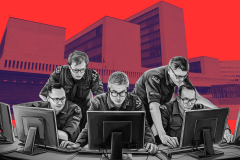The COVID-19 Pandemic has completely changed how the world does things. While the Pandemic lasted, people were busy trying to make things easier so that they could survive until the COVID-19 curve flattened. Now when it has ended, it has revolutionized our workplace trends.
Before the Pandemic, data privacy was a concern for small businesses and big organizations. However, ever since the Pandemic hit the world, data privacy has become one of the top concerns for organizations. As a result, companies worldwide are working hard to address online security strategies. Adapting to data privacy and online security solutions have completely changed workplace trends.
Why has data privacy become a big concern after the pandemic?
During the Pandemic, employees got used to the idea of working remotely. As a result, individuals and companies had no choice but to opt for online alternatives for activities that were otherwise done offline. However, now that the Pandemic is nearly over, these working trends have posed a serious concern — data privacy.
The online alternatives they sought have led to an increase in online traffic, leading to a surge in tracking by private and commercial websites. Sadly, these websites share the information and data they collect with other third parties, which aggravates data privacy concerns.
In addition, third parties aggregate the data to generate user profiles for advertising purposes. These third parties are usually unknown to users whose data they access without their consent.
Sometimes users share a specific type of data with certain websites, which leads to an accumulation of different kinds of data across the websites.
This lets third parties access advanced data analytics and make precise inferences regarding the users’ lives.
These are just some of the activities of third parties that have led to a surge in state and commercial surveillance. Unfortunately, consumers and users have zero control over this.
The world is rapidly digitizing, causing data privacy and online security concerns. However, before moving towards how we can minimize these data privacy issues, let’s discuss the latest workplace trends after the Pandemic that has taken over organizations and businesses all over the globe and is still taking over.
Post-Pandemic Workplace Trends
The concerns for safety and necessity have brought considerable changes in our personal and working lives ever since the Pandemic hit the world. But, thanks to human nature, we all have learned to adopt the new patterns and expectations of our workplaces.
Companies now have the freedom of choosing where and when employees want to work, which is convenient for most of the workforce. Employees this way can balance work and home life better. However, in most offices, this flexibility can be provided, but employees cannot be given this opportunity in many professions and occupations. These industries include retail, healthcare, security, and teaching.
For such lines of work, a hybrid workplace is not an option and has very little influence on their everyday lives. But obviously, such professions and occupations where you cannot work remotely have other trends that technological advancements have brought about.
Here are the most significant workplace trends after the Pandemic:
AI-Augmented Workforce
An AI-augmented workforce is among the five most significant trends that are followed by workplaces. This term sounds a bit complicated when you read it. However, it simply means a combination of technology and employees working side by side on tasks.
When people had no opinion but to work remotely, they had to learn how to use technology in their work. Now it has become a trend, and according to the World Economic Forum, it will lead to about 97 million jobs by 2025.
This would also lead to a change of job roles for existing job holders as employees would be expected to increase their own abilities with AI technology.
However, it is assumed that in the beginning, Artificial Intelligence would be mainly used to convert the repetitive elements of everyday tasks and let the employees focus more on areas that need a greater human touch, such as imagination, emotional intelligence, creativity, and high-level strategy.
This includes occupations and professions like lawyers, doctors, retailers, marketers, manufacturers, and engineers.
Lawyers would be able to utilize the technology to lessen the time spent reviewing the case histories to find any precedents. On the other hand, doctors would have some computer knowledge to analyze the scans and medical records online so that they can effectively diagnose illnesses in their patients.
Augmented analytics is helpful for the retail industry as well.
Managers of stores get help in logistics and inventory planning, whereas the sales assistants can predict what a customer would be looking for when they walk through the door. In addition, AI technology helps marketers with various ever-growing tools to target segment audiences and campaigns.
On the other hand, manufacturers and engineers have widely benefited from an increase in technology that would help them analyze how new machinery would work and predict if any breakdowns are going to occur.
Recruiting for Resilience
Another workplace trend that has taken over the traditional pattern is recruitment or staffing for resilience. Before the Pandemic, organizations prioritized hiring employees that would make an efficient organization.
However, during and after the Pandemic, the emphasis is more on the direction of resilience. Hiring employees with the same skills and built-in redundancy is now perceived as a sensible precaution. Before, it was considered to be something inefficient.
Employee well-being and healthcare
Moreover, employers understand the importance of employee well-being and healthcare. This includes both physical as well as mental health care. Employers are taking these strategies into their game plan to create a more efficient workforce.
The aim is to take responsibility for aiding the employees to maintain better mental, financial and physical well-being. It has become a challenge for organizations and employers to devise ways to do this without being invasive and intrusive in employees’ personal and private lives.
An essential element of resilience is ensuring that the workforce is healthy to keep the business running. However, it also involves aspects like implementing more flexible processes with built-in redundancies to protect against disasters, resulting in compromised operational efficiency.
Hybrid Working
Gone are the days when work would be limited to office premises. Now workplaces have three main models: decentralized, remote organizations, centralized offices, and hybrid working models. A hybrid working model is like having the best of both worlds.
It is assumed that in the coming year, employees will be given the choice of selecting a working model for themselves instead of aligning with whatever the company wants to follow.
In 2020, organizations went through a profound change in their relationship with a centralized workplace, i.e., 69% of big organizations experienced a decrease in the amount of office space needed by their employees. This was because employees preferred remote work over working in offices.
The year 2022 brought about a significant change in the workplace structure.
It would range from maintaining a permanent centralized office with a hot desk to accommodate employees being more likely to work remotely. Hybrid working will be a preferable trend, making some organizations eliminate offices entirely and rely on co-working spaces and having a serviced meeting room.
Research shows that most employees, including managers and workers, are happier when they have the freedom to work from home.
Enhanced Focus on Skills Rather than Roles
Before the Pandemic, organizations’’ focus was on roles rather than the employee’s skills. Now the trend is different. Companies have understood that they need to build a workforce focusing on skills rather than roles. Skills are required to make a company stand out among the rest, not the job roles. A company would have a competitive advantage over others due to a skilled workforce.
To address the challenges of a business, an organization needs a competent and skilled workforce. This was evident when Covid-19 hit the world. Businesses with a competent workforce could stand through the tough times, whereas others could not.
Organizations that focus more on roles have a workforce related to the hierarchy and organizational structure.
Now the trend has changed. Organizations are moving towards a flatter organizational structure rather than sticking to a strict hierarchical team inclined towards a chain of command for problem-solving, communication, and direct reporting.
Now organizations need a skilled workforce that can solve problems and can answer core business questions. A skilled workforce is a key to driving success and innovation within a digital-age organization.
When workers are assisted in developing advanced skills, they have a better chance of growing and capitalizing on new career opportunities rather than just developing their abilities to perform their roles better.
Analytics and Monitoring of Employees
Monitoring and analyzing the behavior of employees was a concept very unfamiliar in the pre-Covid times. Organizations would not pay much attention to such things back then, but now it has become a trend that every organization follows.
As a result, employers are paying attention to investing in various technologies that are helpful in monitoring and tracking the behavior of employees. The need for such an investment is because of the initiative to drive efficiency.
Various platforms help businesses to monitor the behavior of employees across emails.
One of them is Aware. Other tools like Slack help in measuring productivity. Managers use such tools to oversee the remote workforce. Earlier, products like Hitachi’s Business Microscope were used to track employees’ movements during office hours.
For example, how often an employee has taken bathroom breaks or how long an employee took to talk around with other staff compared to sitting in their office block.
Although, using these tools may be perceived by some as an intrusive or overbearing initiative by organizations. However, the idea is to understand employees’’ behavior rather than enforce discipline. As a result, companies will use this technology to increase productivity among their workforce.
The Revolution Data Privacy has brought to Workplace Trends
The post-pandemic workplace trends have imposed a dilemma for employers, which is to outweigh the risks of remote and hybrid working against the benefits of it. The use of technology has created immense data privacy concerns, which are sometimes unbearable for organizations.
The severe problems for data privacy have brought a revolution in the working dynamics. Companies have now taken some necessary steps to ensure data privacy. These steps are as follows:
Minimal Data Collection Practices
Workers and a company’s customers are advised only to collect limited information; the more data a system has, the more likely it is to become a target. If just a username or password can do the job, there is no need to use social security numbers, phone numbers, driver’s license numbers, and addresses.
As a result, workplaces no longer opt to collect additional information which is not needed. This, in return, protects the company itself as well as its customers and also saves extra bandwidth.
Staying Transparent
Organizations are becoming more upfront and clear about the information and data they require for data security. Moreover, companies are considering the diversity of their customer base while working on a privacy policy. There are strict policies implemented that the company would not share the information.
Before the pandemic, policies were full of legalese.
Now companies are trying to ensure that customers are provided with simpler statements so that they can understand what is written.
Data Privacy policies are now informed to customers through Omni channels. The full policy is provided on the initial contact, and a user-friendly version is provided later during different touchpoints with the customer. For example, some companies have telephone customer service, share a summary, and have a FAQ section on the website.
Implementation of Powerful Data Security
Companies have now understood that data privacy is a complicated system that covers many aspects, including the choice of sharing data. Therefore, some robust security measures are implemented to protect the data in a company’s system.
In today’s time, data security is a necessity across multiple layers. It includes understanding as well as classifying the data correctly.
As a result, organizations, whether big or small, are applying all the necessary measures, such as privileged access management, credential choices, access control, web app security, database protection, and sophisticated encryption methods for sensitive data.
Smaller organizations and companies use free security tools such as password managers, Virtual Private Networks, and encrypted storage solutions. A VPN is a smart choice for data privacy and security issues. If a business is low on budget, it can choose among a variety of the cheapest monthly VPNs and secure its online activities.
Application of the Zero Trust Model
Companies are now applying the Zero Trust Model, which restricts access to the whole network by segmenting system entrance and isolation applications based on user permissions, authentication, and user verification.
This helps companies practice policy enforcement and data protection for all devices, users, and applications regardless of where they connect. It is a user-centric approach that makes it mandatory to verify authorized entities.
Awareness and Education of Both Customers and Employees
Last but not least, companies need to create awareness and educate their employees and customers about data privacy and security policies.
In this digitized world, if workers are not aware of the dangers and threats regarding data, they will not be able to take measures to protect themselves and the company from cyber threats.
Companies are working hard to create awareness and educate their workers regarding data privacy concerns.
Conclusion
Workplace trends have changed after the Pandemic. There have been many transformations worldwide after Covid-19, among which privacy and security concerns remained a top priority.
As companies digitized their operations and workplace trends changed, companies had to put privacy issues into perspective.
It can be said that data privacy completely revolutionized workplace dynamics as security measures had to be in place at every step.
As workers are now working remotely, they must ensure that the company and user data is protected. Various tools and protective measures follow the latest workplace trends, while security is also prioritized.
Featured Image Credit: Provided by the Author; Unsplash; Thank you!


















